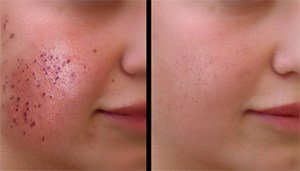CROSS Technique (Chemical Reconstruction of Skin Scars)

Acne is a common skin disorder that is caused by hormonal action on the sebaceous glands (oil secreting glands) of the skin. Hormones act on the skin's oil glands and hair follicles leading to clogged pores and lesions which we commonly call pimples. These usually form on your face, neck, back, chest, and shoulders. Even though acne does not lead to a serious health problem, it can lead to emotional disturbances such as low self esteem. When it is severe, it can even leave behind permanent scars.
Acne scars can be classified into two major types based on the response of the tissues to the inflammation as follows:
- Scars formed by increased tissue formation–Hypertrophic or Keloid scars
- Scars formed by loss of tissue
- Ice-pick scars
- Boxcar scars
- Rolling scars
- Depressedfibrotic scars
- Superficial and deep soft scars
- Atrophic macules
There are various treatment modalities available for reconstructing and improving the appearance of acne scars, including punch excision, punch elevation, subcutaneous incision (subcision), dermal fillers (liquid injectable silicone, hyaluronic acid), chemical skin resurfacing, and laser skin resurfacing. A combination of one or more modalities may be necessary to produce improvement in acne scars.
One such therapy for treatment of acne scars is CROSS (chemical reconstruction of skin scars) technique. The CROSS technique is a method of chemically reconstructing skin scars using a local application of high concentration of trichloroacetic acid (TCA). Concentrations up to 100%, are applied to the depressed area of the scar using a wooden applicator and is pressed down firmly into the scar bed for 1 minute. This causes necrosis in the floor of the scar, which when healed results in elevation of the floor. The application produces multiple, frosted white spots on each acne scar. Before CROSS is performed, the skin will be primed with 8Quin cream nightly for 2 weeks, and thereafter for the duration of the sessions. Local anesthetics or sedation are not needed for CROSS. The area is cleansed and prepped with alcohol prior to application. The higher concentration of TCA increases the dermal thickening and collagen production which helps in reconstructing the acne scars. This technique reduces scarring and hypopigmentation of the adjacent normal skin and healing is rapid.
Mild stinging sensation may be felt during the procedure. An antibiotic ointment is applied to the treated areas after the procedure, and used until crust formation occurs. Sometimes, adverse effects such as mild redness or temporary skin darkening may occur, but will resolve within 4-6 weeks.
Repeated treatments with CROSS technique can resurface deep rolling and boxcar scars as well as deep icepick scars. CROSS is repeated every month until maximal change is achieved, usually within 4-6 sessions.
This technique can also treat chicken pox scars and dilated pores, as well as reconstructing depressed surgical scars.
